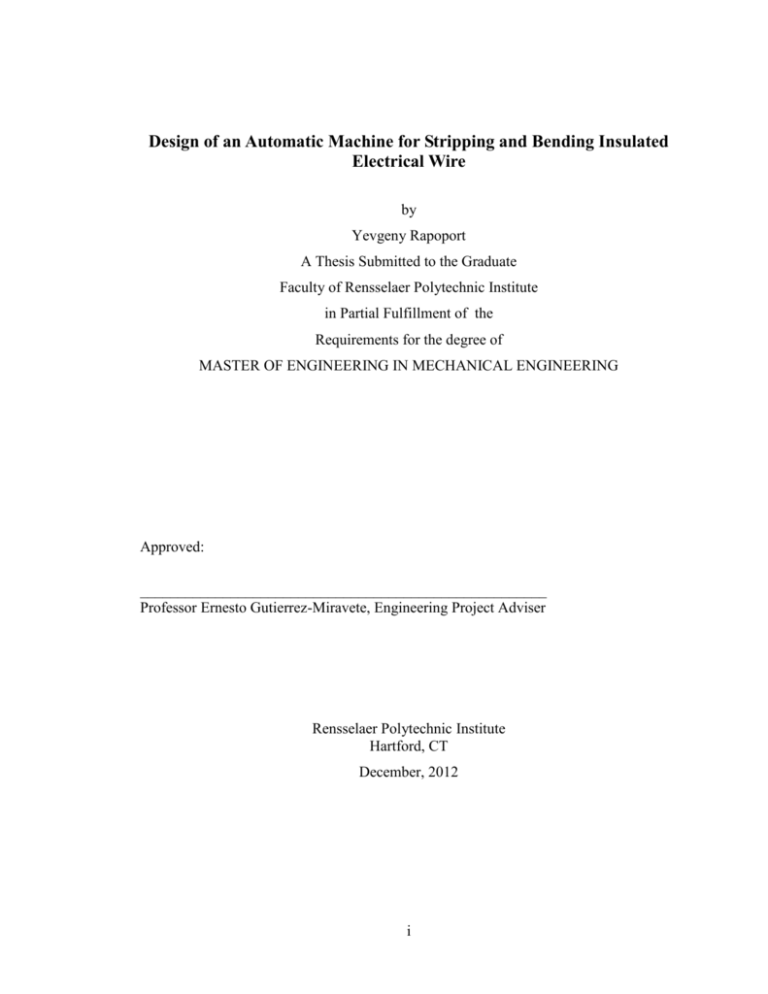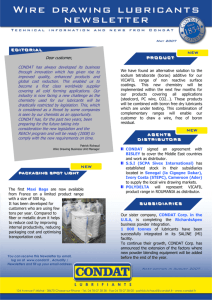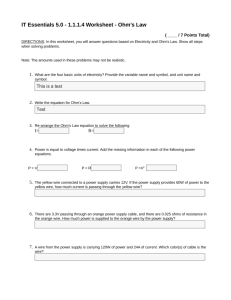
Design of an Automatic Machine for Stripping and Bending Insulated
Electrical Wire
by
Yevgeny Rapoport
A Thesis Submitted to the Graduate
Faculty of Rensselaer Polytechnic Institute
in Partial Fulfillment of the
Requirements for the degree of
MASTER OF ENGINEERING IN MECHANICAL ENGINEERING
Approved:
______________________________________________________
Professor Ernesto Gutierrez-Miravete, Engineering Project Adviser
Rensselaer Polytechnic Institute
Hartford, CT
December, 2012
i
© Copyright 2012
by
Yevgeny Rapoport
All Rights Reserved
ii
CONTENTS
LIST OF TABLES ............................................................................................................. v
LIST OF FIGURES .......................................................................................................... vi
NOMENCLATUE ........................................................................................................... vii
ACKNOWLEDGMENT ................................................................................................ viii
ABSTRACT ..................................................................................................................... ix
1. Introduction.................................................................................................................. 1
1.1
1.2
Background ........................................................................................................ 1
1.1.1
Automation............................................................................................. 1
1.1.2
Machine Function................................................................................... 1
Problem Description........................................................................................... 2
1.2.1
Requirements and Specifications ........................................................... 2
2. Machine Design ........................................................................................................... 3
2.1
2.2
2.3
2.4
2.5
Subsystem #1: Free-Length Uncoiling Mechanism ........................................... 3
2.1.1
System Description ................................................................................ 3
2.1.2
Analytical Support ................................................................................. 4
Subsystem #2: Primary Feed Mechanism .......................................................... 6
2.2.1
System Description ................................................................................ 6
2.2.2
Analytical Support ................................................................................. 8
Subsystem #3: Guide Tube ................................................................................ 8
2.3.1
System Description ................................................................................ 8
2.3.2
Analytical Support ................................................................................. 9
Subsystem #4: Cutting and Stripping Mechanism ............................................. 9
2.4.1
System Description ................................................................................ 9
2.4.2
Analytical Support ............................................................................... 10
Subsystem #5: Secondary Feed Mechanisms .................................................. 11
2.5.1
System Description .............................................................................. 11
iii
2.5.2
2.6
2.7
Analytical Support ............................................................................... 12
Subsystem #6: Walking Beam ......................................................................... 13
2.6.1
System Description .............................................................................. 13
2.6.2
Analytical Support ............................................................................... 14
Subsystem #7: Bending Mechanism ................................................................ 14
2.7.1
System Description .............................................................................. 14
2.7.2
Analytical Support ............................................................................... 15
3. Full Machine .............................................................................................................. 16
3.1
Machine Description ........................................................................................ 16
3.2
Control System ................................................................................................. 16
iv
LIST OF TABLES
Error! No table of figures entries found.
v
LIST OF FIGURES
Figure 1: General Machine Layout .................................................................................... 2
Figure 2: Uncoiling Mechanism ........................................................................................ 3
Figure 3: Primary Feed Mechanism .................................................................................. 6
Figure 4: Guide Tube Mechanism ..................................................................................... 8
Figure 5: Cutting / Stripping Mechanism .......................................................................... 9
Figure 6: Secondary Feed Mechanisms ........................................................................... 11
Figure 7: Walking Beam .................................................................................................. 13
Figure 8: Bending Mechanism......................................................................................... 14
Figure 9: Full Machine .................................................................................................... 16
vi
NOMENCLATUE
Angular Velocity (rad/sec)
f
Frequency (rpm)
Angular Acceleration (rad/sec2)
T
Torque (ft-lbs)
I
Rotational Inertia (lb-ft2)
Coefficient of Friction (dimensionless)
r
Radius (in)
F
Force (lb)
vii
ACKNOWLEDGMENT
I would like to thank my family for continued support and inspiration during my
education. I would also like to thank the faculty at RPI Hartford and Troy, especially
Professor Ernesto Gutierrez-Miravete, for his guidance.
viii
ABSTRACT
The aim of this project is to produce the mechanical design of an automatic machine for
manufacturing segments of heavy gauge insulated electrical wire with both ends stripped
and bent at 90 degrees from a spool stock of insulated electrical wire. These wire
segments would be used in the assembly of electrical components such as battery banks,
prefabricated circuit breaker panels, and other components where jumper/bridge
segments are required. The design of the automatic wire stripping and bending machine
will utilize seven subsystems which together compose the machine. Design of the
machine is performed using Computer Aided Design (CAD) software to produce a 3D
model of the machine. Each subsystem is shown and key design features are discussed
with supporting rational for their implementation. Supporting calculations are performed
to size various components used in each subsystem and load bearing areas throughout
the machine are evaluated for stress. A timing diagram and input/output (I/O) listing is
developed and a programmable logic controller (PLC) model selected to define the
control system. The 3D CAD model allows a potential customer or colleague to produce
2D drawings for manufacture and assembly of the automatic machine.
ix
1. Introduction
1.1 Background
1.1.1
Automation
Automation of a manufacturing process plays a vital role in reducing a company's
production costs. The primary reasons for automating a manufacturing process are
reducing labor costs, reducing waste, improving quality, increasing repeatability,
reducing employee injuries, and allowing uninterrupted production.
1.1.2
Machine Function
The function of the automatic wire stripping and bending machine presented in this
report is to produce segments of insulated electrical wire with both ends stripped from a
spool of insulated wire. These segments are cut to lengths varying from 5 to 24 inches,
and the stripped ends bent 90 degrees. The production rate of this machine is anticipated
to produce a finished segment of wire every five seconds. Figure 1 shows the general
layout of the seven subsystems, which together compose the machine. The automation of
this process serves to replace the manual human operations previously used to produce a
segment of wire as described above.
1
Figure 1: General Machine Layout
1.2 Problem Description
1.2.1
Requirements and Specifications
The requirements and specifications for the automatic wire stripping and bending
machine are as follows:
Produce wire segments with lengths ranging from 5 inches to 24 inches.
Remove up to 1 inch of insulation from both ends of the wire segment.
Bend both stripped ends of the wire segment 90 degrees in the same direction.
Uncoil insulated wire automatically from spool stock.
Produce a finished wire segment every 5 seconds.
Control the automatic machine through a Programmable Logic Controller (PLC).
Pneumatics of the machine to use 90 psi shop air supply.
Simple manual adjustment for different segment length production runs.
Hands free operation once setup and programmed for specific segment length.
Sensor feedback to stop machine and notify operator when jam or malfunction
occurs.
Machine to be located on bench top when in use.
2
2. Machine Design
2.1 Subsystem #1: Free-Length Uncoiling Mechanism
2.1.1
System Description
Figure 2: Uncoiling Mechanism
Subsystem #1, shown above in Figure 2, uncoils a free-length amount of wire from a
spool stock of insulated wire. The mechanism consists of a drive roller (part number
(PN) X) with an idle roller which is tensioned against the insulated wire by a spring (PN
X). The drive roller is rotated by and DC electric motor (PN 1). The free-length is
regulated by two inductive proximity switches.
The two proximity switches are used to provide feedback to the mechanism which
uncoils wire from the spool stock. The proximity switches are located at a set distance
vertically apart from each other to provide a free length of wire 72 inches in length. As
the lower sensor detects the wire it will cause the uncoiling mechanism to stop. Once
the free length of wire is consumed by the machine the free length of wire is shortened to
the point where the upper proximity sensor detects the wire and provides a signal to turn
3
the uncoiling mechanism on until the wire droops into the detecting space of the lower
sensor.
2.1.2
Analytical Support
2.1.2.1 Electric Motor
The design of Subsystem #1 is based on uncoiling a 20 inch diameter spool of #12
single-conductor insulated copper wire weighing 62.5 lbs. Subsystem #1 is designed to
uncoil a free-length of wire 72 inches long in 2 seconds. To achieve this requirement, a
20 inch diameter spool must rotate at 35 rpm. For conservatism, a 1 second time to reach
35rpm is assumed when calculating the required torque. The torque required to rotate the
spool is given by the following, where 308 is a combined constant converting minutes
into seconds, weight into mass and radius into circumference:
T
N WR 2
t 308
35rpm 21.7lb ft 2
1 sec 308
2.47 ft lb
(1)
The pull force required to meet above torque requirement at the outer perimeter of the
spool is calculated:
F
T 2.47 ft lb
2.97lb
r
10in
(2)
The above pull force is used to calculate the required minimum torque for the motor (PN
X in Figure 2) coupled to the 1.7 inch diameter drive pulley (PN X in Figure 2):
TM F r 2.97lb 0.85in 2.52in lb
(3)
From the results of equations (1) through (3), a NEMA 34 frame electric stepper motor,
as selected in the design, provides sufficient margin for required torque to uncoil 72
inches of wire in 2 seconds. NEMA 34 stepper motors typically range in maximum
4
torque ratings from 18in-lb to 75in-lb. In addition, the margin for required torque would
allow the spool size to be increased in size and weight.
2.1.2.2 Extension Spring
Based on an assumed coefficient of friction of 0.25 for aluminum with nylon, the
clamping force required between the drive pulleys is as follows:
FN
F
2.97lb
11.88lb
0.25
(4)
Based on the dimensions of the idle pulley arm (PN X in Figure 2), the required
extension spring (PN X in Figure 2) is selected to provide a compressive load of 6lb.
2.1.2.3 Shafts
2.1.2.4 Bearings
5
2.2 Subsystem #2: Primary Feed Mechanism
2.2.1
System Description
Figure 3: Primary Feed Mechanism
The primary feed mechanism, shown in Figure 3, draws insulated wire from the free
length of wire maintained by Subsystem #1. This wire is fed along through the guide
tube of Subsystem #3. The rollers of this mechanism are driven by an electric stepper
motor (PN X in Figure 3), timing pulleys (PN X in Figure 3), and timing belt (PN X in
Figure 3). An idle roller attached to a tension block is used to tension to the timing belt
and provide engagement across all three timing pulleys. The tension block functions by
housing two compression springs guided by two shoulder bolts with bushings. The lower
idle pulleys (PN X in Figure 3) are mounted to a floating housing which is tensioned
6
against the drive pulleys in a similar fashion as the timing belt tension block described
above. The lower idle pulleys provide a compressive load against the insulated wire and
drive pulleys, thus preventing any slip in the drive mechanism.
The wire length is determined by the amount of rotations of the drive wheels to
accurately measure out the length of wire to be cut by the cutting/stripping station
(Subsystem #4). This subsystem also moves the wire in reverse to perform the stripping
operation once the jaws of Subsystem #4 are clamped down in the strip position.
7
2.2.2
Analytical Support
2.3 Subsystem #3: Guide Tube
2.3.1
System Description
Figure 4: Guide Tube Mechanism
The funneled guide tube (PN X in Figure 4) guides the insulated wire to the
stripping/cutting station and performs addition straightening of the wire. The funneled
tube is interchangeable for different gauge wire and is mounted to a solenoid (PN X in
Figure 4) actuated rotation assembly. The rotation of the guide tube allows for the
leading end of the following wire to be moved out of the way when a segment of wire is
back-fed into the stripping/cutting station for the second stripping operation.
8
2.3.2
Analytical Support
2.4 Subsystem #4: Cutting and Stripping Mechanism
2.4.1
System Description
Figure 5: Cutting / Stripping Mechanism
The cutting and stripping operations are performed by a set of dies which are actuated by
a linear cam mechanism. This linear cam plate (PN X in Figure 5) is actuated by a
pneumatic cylinder (PN 17), which produces a clamping motion via cam followers (PN
X in Figure 5) on each of the clamp arms (PN X in Figure 5). The stripping/cutting die
(PN X in Figure 5) is interchangeable for different gauge wires. The initial end of the
wire is fed into the stripping station, the jaws contract over the wire with the dies. This
stripping position is set by and intermediate stop which is engaged by a smaller
9
pneumatic cylinder (PN X in Figure 5). Once the insulation is cut, the feed mechanism
from Subsystem #2 rotates in reverse to pull the insulation off the end of the wire.
The wire is then fed forward for a predetermined segment length and captured by the
secondary feed mechanism (Subsystem #4). The wire is cut by allowing the pneumatic
cylinder attached to the linear cam plate (PN X in Figure 5) to go through its entire
stroke. In order to strip the second end of the wire segment, the guide tube of Subsystem
#2 is rotated upwards, the feed mechanism of Subsystem #4 feeds the segment in reverse
through the stripping jaws where the action described in the paragraph above is
performed again.
2.4.2
Analytical Support
10
2.5 Subsystem #5: Secondary Feed Mechanisms
2.5.1
System Description
Figure 6: Secondary Feed Mechanisms
The secondary feed mechanism is identical to the one shown in Figure 3 except a sensor
is incorporated into the right-most idle pulley. The sensor allows the machine to sense
when the segment of wire has been completely transferred to the drop slide, shown in
Figure 6.
11
The sensor dictates when the drop slide opens and allows the stripped wire segment to
fall onto the walking beam. For this sensor a magnetic reed switch is used. The stripped
wire segment will travel over an idle roller when being transferred from the secondary
feed mechanism to the drop tray. This idle roller will contain a magnet which the reed
switch will be able to sense when the idle roller is rotating. This will allow the machine
to determine when the wire segment has been completely transferred the secondary feed
mechanism to the drop tray. Once the wire segment is in the drop tray (Figure 6), the
tray can open and drop the wire segment onto the walking beam (Subsystem #6). The
magnetic reed switch allows for the timing of opening the drop tray without the wire
segment becoming jammed in the feed mechanism.
The drop slide mechanism consists of a hinged sheet metal plate (PN X in Figure 6)
which can accommodate lengths of wire 5 inches through 24 inches without adjustment.
The drop slide is opened by a pneumatic cylinder (PN X in Figure 6), allowing the wire
to fall onto the first step of the stationary portion of the walking beam mechanism
(Subsystem #5).
2.5.2
Analytical Support
12
2.6 Subsystem #6: Walking Beam
2.6.1
System Description
Figure 7: Walking Beam
A walking beam mechanism, shown in Figure 7, is used to move the stripped wire
segment from the path of cutting and stripping to the bending station. The bending
station (Subsystem #7) is incorporated into the stationary portion of the walking beam
and is discussed in paragraph 2.7.1.
The walking beam is actuated by rotating four offset hubs (two on each side) mounted in
the stationary portion of the walking beam. The rotation of the hubs is driven by an
electric motor and timing belts. Rotation from the electric motor to the rotating hub is
transferred via a solenoid activated clutch (PN X in Figure 7). The motor operates
constantly and when a wire segment is dropped from Subsystem #4, the clutch is
engaged for one revolution of the walking beam. The walking beam is adjustable for
lengths of wire 4 inches to 24 inches by turning an acme screw (PN X in Figure 7),
which will move the second assembly along two liner slides (PN X in Figure 7). The
13
adjustable side of the walking beam is driven by a hex shaft (PN X in Figure 7) through
hex bushings (PN X in Figure 7).
2.6.2
Analytical Support
2.7 Subsystem #7: Bending Mechanism
2.7.1
System Description
Figure 8: Bending Mechanism
14
The bending of both stripped ends is completed by actuating two dies vertically down
with pneumatic cylinders (PN X of Figure 8). The dies are slightly offset from the edge
of the walking beam stationary rail to account of the thickness of the un-insulated wire.
A spring (PN X of Figure 8) loaded guide block is incorporated into the die to prevent
the wire from moving during the bending operation. The die is mounted on a linear slide
(PN X of Figure 8) to provide smooth, rigid motion. The gantry style setup is adjustable
for the 5 inch to 24 inch wire lengths by moving the right side assembly on a linear slide
(PN X of Figure 8), and locking it in place.
After the bending operation is complete, the part will be removed during the next cycle
of the walking beam (Subsystem #5) and dropped on a slide where the wire segments
can be collected in a bin.
2.7.2
Analytical Support
15
3. Full Machine
3.1 Machine Description
Figure 9: Full Machine
3.2 Control System
16






